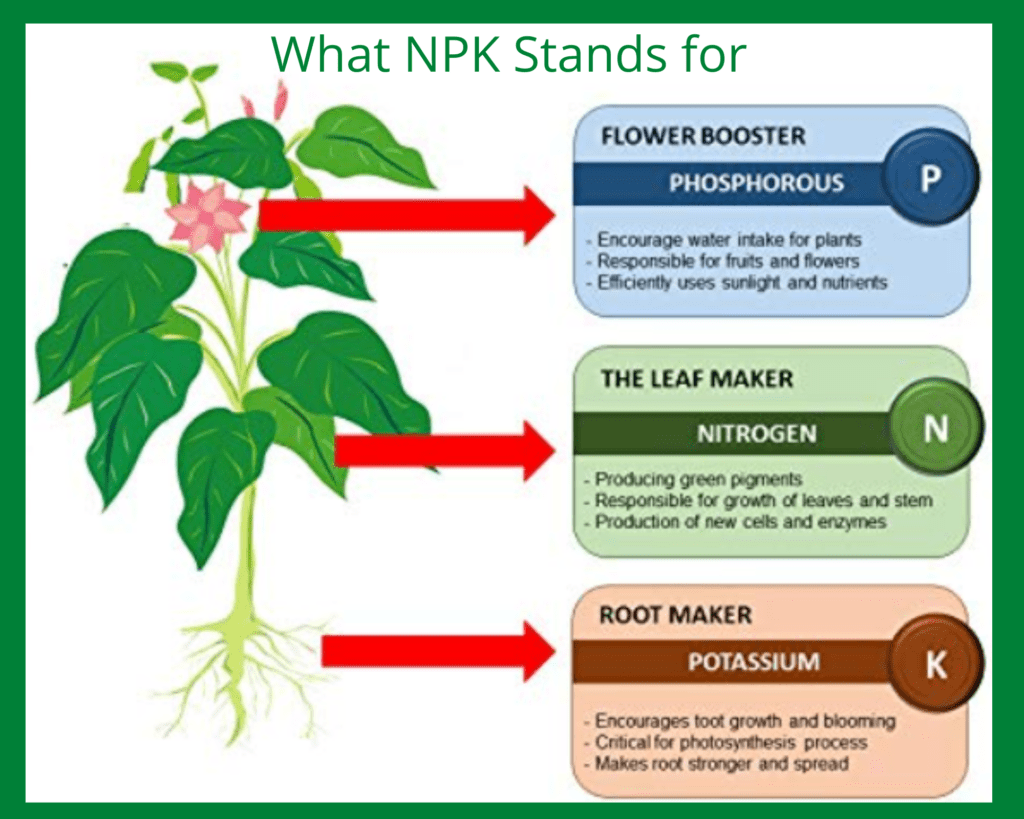You might have come across this term NPK mostly on bags of fertilizers or boxes during your walk to the stores, nursery, or garden centers. It may be organic or inorganic fertilizer. So, what does NPK stand for?
NPK in fertilizer stands for Nitrogen (N), Phosphorus (P), and Potassium (K), indicating the ratio or percentage composition of the three important nutrients for plants in a fertilizer.
N-P-K Meaning in Fertilizer
NPK simply represents the three macro-nutrients that are needed for the healthy growth of a plant. They include nitrogen (N), phosphorus (P), and potassium (K) or NPK. It’s important to note that the higher the number, the more concentrated the nutrients are in that fertilizer.
N-P-K numbers simply reflect nutrients percentage by weight. For example, you may find a bag of Pennington Ultragreen Lawn Fertilizer 30-0-4 indicates that the bag contains 30%N, 0%P, and 4%K, plus other important ingredients.
It is very important to always have your soil texted before applying any kind of fertilizer in your garden beds as this will help you in determining how to balance fertilizer numbers that are required in your soil.

How does NPK Fertilizer help Plants? (Grass)
Now you know the meaning of NPK in fertilizers, it’s important to know why you need them in your grass lawn. Without proper or enough of these three nutrients, your grass may become unhealthy or dry up. The following are the nutritional benefits of NPK fertilizers:
Nitrogen (N)
Nitrogen is commonly used in the growth of green foliage in plants such as grass. It is responsible for leaf development. Nitrogen is vital as it forms the major component of chlorophyll which is the green coloring matter of a plant.
It contains amino acids which are known to be the building blocks of proteins in the grass.
Nitrogen deficiency in plants may result in slow growth, turning plants to look pale in color while too much of it causes luxuriant growth hence attracting pathogens and insects.
Phosphorus(P)
Phosphorous plays a key role in the development of the root system in the grass which is the support system of a plant. it is important in the production of fruits in plants and lack of phosphorus results in the production of weak plants which will be prone to discoloration, drooping, and shortage of fruits.
Potassium (K)
Potassium plays a key role during photosynthesis as it regulates the opening and closing of stomata thus regulating the intake of CO2 in plants. Its aids in triggering the activation of essential enzymes in the production of Adenosine Triphosphate ATP which is the source of energy for chemical processes in plants.
Potassium regulates water intake in plants (Osmoregulation) and is required during the synthesis of protein and starch enzymes. The compound helps in fighting diseases in plants and its deficiency may result in chlorosis, stunted growth, and poor resistance to ecological changes.
When to use NPK Fertilizer on your lawn
It’s always good to keep your lawn green throughout the year, however, this can be achieved by choosing fertilizer that meets the needs of different seasons of the year. This is a guide on what one is expected to carry out during the four seasons:
1. Early spring
During this season the temperatures are warm and is a period when a seed starts to germinate. You need to prevent new weeds from germinating into your lawn by feeding it with NPK. Timing is always crucial as this will prevent their roots from being established hence controlling new weeds for a period of five months.
2. Late spring
This is a period between April and June. During this season the existing weeds are actively growing, you need to weed and fertilize your lawn as this will provide nutrients and active growth of your lawn. You can use Scotts turf builder or any other NPK fertilizer suitable for your soil needs.
For best results apply fertilizer when the grass is still wet with dew that is early morning ensuring that there is no rain for at least two days.
3. Summer
During this period which is between June and August, it is good to ensure that you feed your lawn with NPK fertilizer well as this will strengthen the grass against heat and drought. You need to feed your lawn for up to three months as this will provide essential nutrients to your grass.
Always ensure to check the tag for your grass type and follow the instructions given, NPK fertilizers can be applied on wet or dry lawns therefore no need to worry about fertilizer burn.
4. Fall
In the season between August and November, the growth of grass slows down as it makes it in for the winter month. It is at this time when weeds start to grow actively, therefore it is advisable to use Pennington ultra-green winterize plus weed and feed fertilizer 22-0-14 in your lawn for essential nutrients and to kill the broadleaf weed.
Also Check: Is 10-10-10 fertilizer good for lawns?
Final Thought
By following instructions correctly as directed on the label, you can never go wrong when fertilizing your lawn. Incorrect use of fertilizer is harmful to your plants, animals, and the environment.